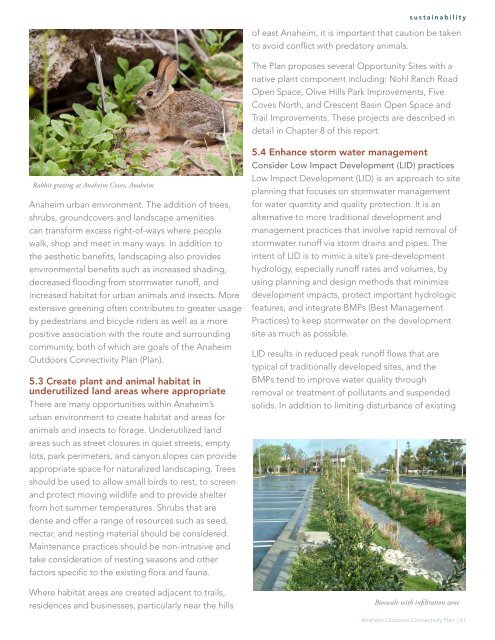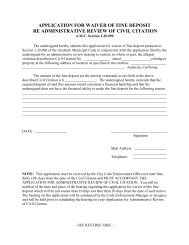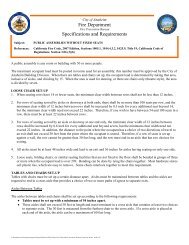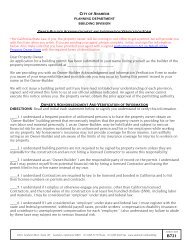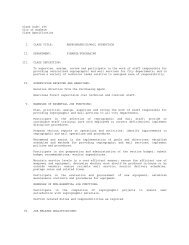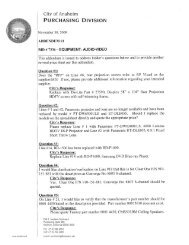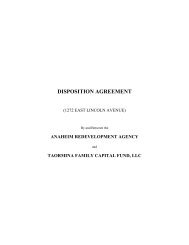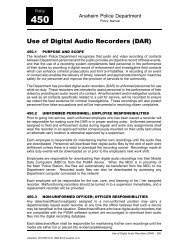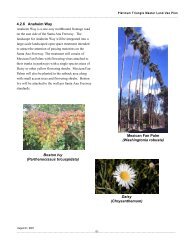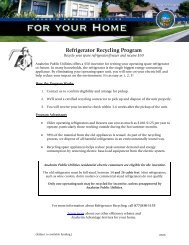AnaheimOUTDOORS - City of Anaheim
AnaheimOUTDOORS - City of Anaheim
AnaheimOUTDOORS - City of Anaheim
Create successful ePaper yourself
Turn your PDF publications into a flip-book with our unique Google optimized e-Paper software.
sustainability<br />
<strong>of</strong> east <strong>Anaheim</strong>, it is important that caution be taken<br />
to avoid conflict with predatory animals.<br />
The Plan proposes several Opportunity Sites with a<br />
native plant component including: Nohl Ranch Road<br />
Open Space, Olive Hills Park Improvements, Five<br />
Coves North, and Crescent Basin Open Space and<br />
Trail Improvements. These projects are described in<br />
detail in Chapter 8 <strong>of</strong> this report.<br />
Rabbit grazing at <strong>Anaheim</strong> Coves, <strong>Anaheim</strong><br />
<strong>Anaheim</strong> urban environment. The addition <strong>of</strong> trees,<br />
shrubs, groundcovers and landscape amenities<br />
can transform excess right-<strong>of</strong>-ways where people<br />
walk, shop and meet in many ways. In addition to<br />
the aesthetic benefits, landscaping also provides<br />
environmental benefits such as increased shading,<br />
decreased flooding from stormwater run<strong>of</strong>f, and<br />
increased habitat for urban animals and insects. More<br />
extensive greening <strong>of</strong>ten contributes to greater usage<br />
by pedestrians and bicycle riders as well as a more<br />
positive association with the route and surrounding<br />
community, both <strong>of</strong> which are goals <strong>of</strong> the <strong>Anaheim</strong><br />
Outdoors Connectivity Plan (Plan).<br />
5.3 Create plant and animal habitat in<br />
underutilized land areas where appropriate<br />
There are many opportunities within <strong>Anaheim</strong>’s<br />
urban environment to create habitat and areas for<br />
animals and insects to forage. Underutilized land<br />
areas such as street closures in quiet streets, empty<br />
lots, park perimeters, and canyon slopes can provide<br />
appropriate space for naturalized landscaping. Trees<br />
should be used to allow small birds to rest, to screen<br />
and protect moving wildlife and to provide shelter<br />
from hot summer temperatures. Shrubs that are<br />
dense and <strong>of</strong>fer a range <strong>of</strong> resources such as seed,<br />
nectar, and nesting material should be considered.<br />
Maintenance practices should be non-intrusive and<br />
take consideration <strong>of</strong> nesting seasons and other<br />
factors specific to the existing flora and fauna.<br />
Where habitat areas are created adjacent to trails,<br />
residences and businesses, particularly near the hills<br />
5.4 Enhance storm water management<br />
Consider Low Impact Development (LID) practices<br />
Low Impact Development (LID) is an approach to site<br />
planning that focuses on stormwater management<br />
for water quantity and quality protection. It is an<br />
alternative to more traditional development and<br />
management practices that involve rapid removal <strong>of</strong><br />
stormwater run<strong>of</strong>f via storm drains and pipes. The<br />
intent <strong>of</strong> LID is to mimic a site’s pre-development<br />
hydrology, especially run<strong>of</strong>f rates and volumes, by<br />
using planning and design methods that minimize<br />
development impacts, protect important hydrologic<br />
features, and integrate BMPs (Best Management<br />
Practices) to keep stormwater on the development<br />
site as much as possible.<br />
LID results in reduced peak run<strong>of</strong>f flows that are<br />
typical <strong>of</strong> traditionally developed sites, and the<br />
BMPs tend to improve water quality through<br />
removal or treatment <strong>of</strong> pollutants and suspended<br />
solids. In addition to limiting disturbance <strong>of</strong> existing<br />
Bioswale with infiltration zone<br />
<strong>Anaheim</strong> Outdoors Connectivity Plan | 61


